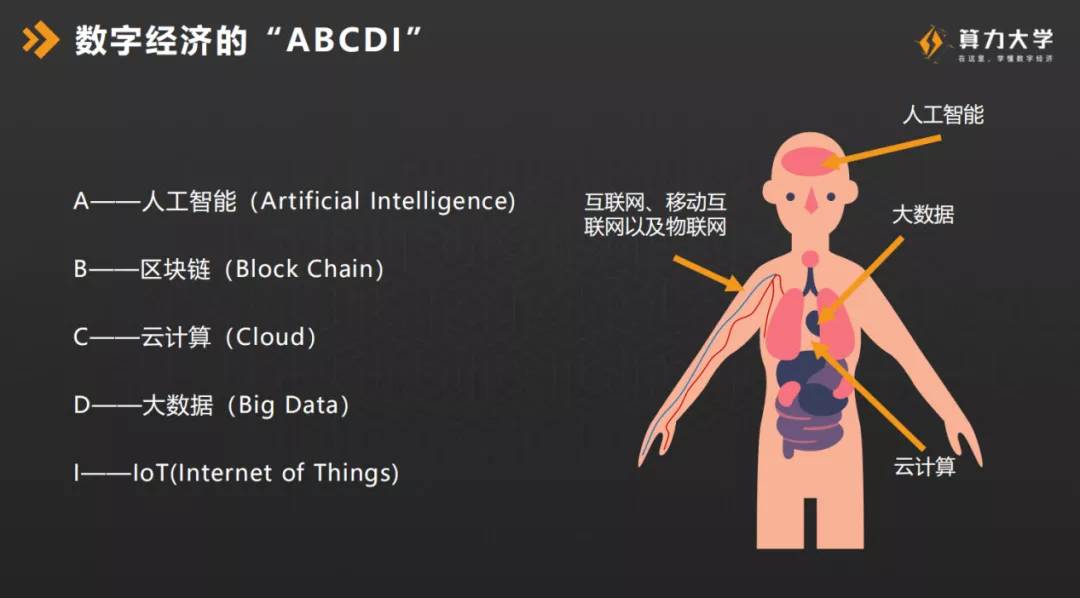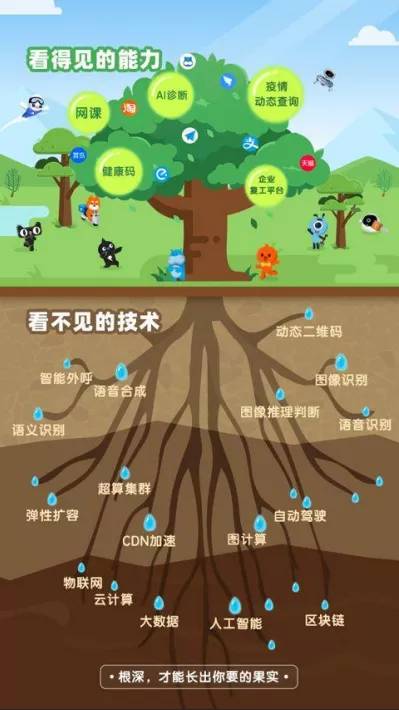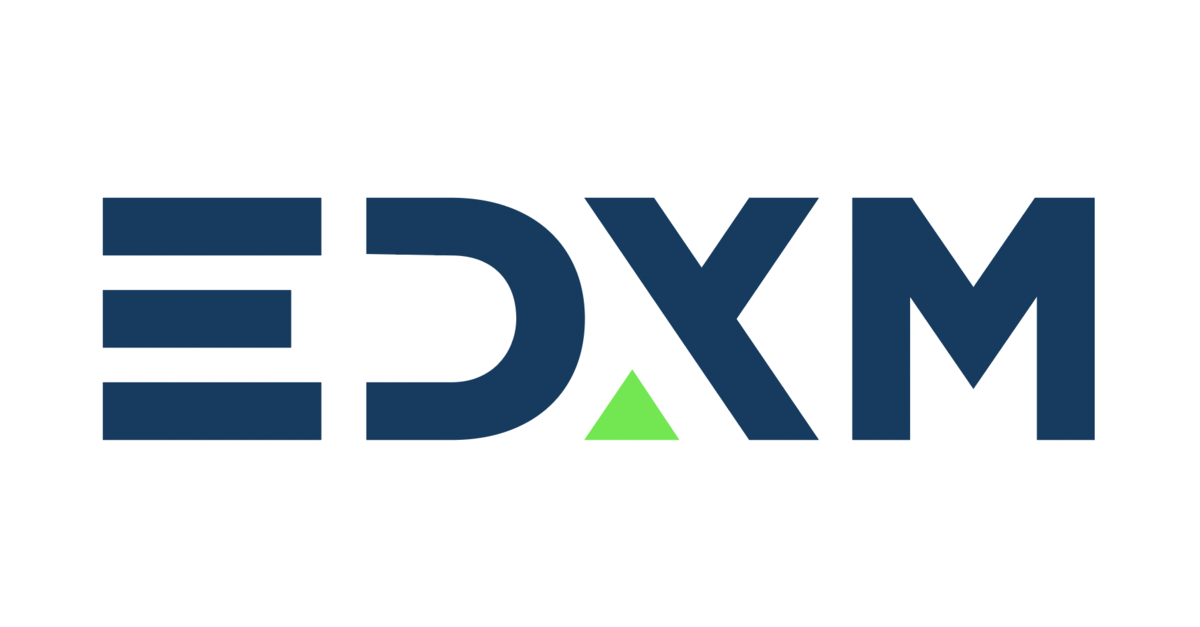Depth | Business opportunities brought by ABCDI in the era of digital new infrastructure
2020 is known as the first year of China's digital economy. Due to the new crown epidemic that broke out across the globe, the need for a non-contact economy has forced us to accelerate the embrace of digitalization.
In this process, what technologies will break out and what opportunities are worth seizing? From the perspective of digital economy industry synergy, the founder of the computing power think tank Yan Li explained how to seize the dividends of the growth of the digital economy industry in the current global economic turmoil. Yan Li said that the ability to digitize is the right to survive, and the development of the future digital economy industry is the synergy of various technologies.
1Digital capabilities will determine the survival of an enterprise
2020 is known as the first year of China's digital economy. Due to the new crown epidemic that broke out across the globe, the need for a non-contact economy has forced us to accelerate the embrace of digitalization.
Through this crisis, we have found that traditional enterprises could choose to join the digitalization process and choose to delay the digitalization process. Today, traditional enterprises must embrace emerging technologies such as blockchain, artificial intelligence and big data to become a digital real economy in order to obtain better viability.
- Analysis | Market bulls are eager to move, but the callback risk cannot be ignored
- Opinion | President of the Brazilian Banking Federation: Cryptocurrencies are not real currencies and do not perform any function of currency
- Comprehensive understanding of the progress of the Bitcoin network: the daily transaction volume has increased to 340,000, and the total number of Bitcoin wallets on the entire network has reached 47 million
The ability to digitize is the right to survive, so 2020 is the first year of China's digital economy.
The core of the digital economy is big data, identifying-selecting-filtering-storing-using, guiding, realizing the rapid optimization of resource allocation and regeneration, and realizing the economic form of high-quality economic development.
Through continuous upgrading of network infrastructure and smart phones and other information tools, Internet-cloud computing-blockchain-Internet of things and other information technologies, human beings' ability to process the quantity, quality and speed of big data has been continuously enhanced to promote the development of the human economic form. The transformation from industrial economy to information economy-knowledge economy-smart economy.
In another sense, the digital economy is also one of the essential characteristics of Industry 4.0 or the industrial economy.
The digital economy was first proposed in China's government report in 2017, and the 2019 Central Economic Conference clearly stated that it is necessary to vigorously develop the digital economy.

From a measurement perspective, the average return on digital technology investment is about 6.7 times that of non-digital technology investment. This is still based on 2018 data. According to the entire data of 19 years, including the first half of 2020, because other industries are basically in a relatively shrinking state, this comparison will be even stronger.
Data is the most important factor of production in the digital economy, because when we talk about economy, it is the major weights of factors of production, productivity, and production relations.
Vice Premier Liu He published an article in the People's Daily on November 22, 19, stating the prominent role of data in improving production efficiency. Data as an independent new factor of production will help realize the value of other factors data. And this new element must be confirmed before it can be shared and traded publicly.
Data is classified as a factor of production, which means that data can be used by enterprises to produce goods and services just like other factors of production such as labor, capital, and land. It is worth noting that there is no upper limit for data resources compared to land and labor, and its growth rate can increase exponentially.
2Data is the most important factor of production, but faces many challenges
If we can make full use of such an inexhaustible element, it can bring great impetus to the economy. Although data is so important, data also faces many challenges.

1. Storage of massive data. Regardless of whether it is static data or dynamic data, whether it is cold data or hot data, it is facing the problem of storing big data, and the amount of this data production will become larger and larger. The corresponding infrastructure is the IDC computer room, supercomputer center There is also the distributed storage mentioned in the blockchain field. With such a data pain point, a corresponding set of infrastructure is also needed as support.
2. Data communication and interaction. Data has to play a role, not static, but to allow data to interact, flow, and share. The infrastructure requirements are network and bandwidth.
3. Confirmation of data. Data is very easy to copy and difficult to determine. Whether it is in the right to information, intellectual property rights, or a large number of piracy in our film and television works, etc., it is actually a mapping, indicating that data can be easily copied and rights cannot be confirmed.
4. Data islands and privacy protection. In our daily production, in fact, the data island effect widely exists. Data has not been circulated, and data islands exist widely. There is also an extended problem. A large amount of data is closely related to each of us's daily life information, production information and personal privacy. Therefore, data protection has become an important issue facing big data.
5. How to identify the authenticity of the data? A large amount of data may be useless data and false data, which needs to be identified to play the true role of the data.
6. Data pricing and transactions. Although data is very important, how to price data is very important.
These are the challenges facing data, but also the opportunities that exist in the data economy.
3 Industrial digitization and digital industrialization under the collaboration of "ABCDI"
Today my topic is called ABCDI of the digital economy, that is, artificial intelligence, blockchain, cloud computing, big data, and the Internet of Things. These are the five most important modules in the digital economy that I think are currently in use. I replaced the original E , edge computing with I , the Internet of Things.

If the Internet, mobile Internet, and the Internet of Things are equivalent to a person's nervous system, big data is equivalent to a person's internal organs and skin, and cloud computing is more like a person's spine. Artificial intelligence is the human brain. The blockchain is more like external DNA, which can make your bones stronger, make your brain smarter, and make your skin brighter.
The core functions of cloud computing are computing capabilities, storage capabilities, and channel capabilities. The core functions of big data are static data, dynamic data, and superimposed data that are newly created after being used. The core of artificial intelligence is to filter the redundancy in big data, turn the data into knowledge through deep mining, and help humans make decision-making judgments at work.
As a special Internet technology, the core of blockchain is to generate a new trust mechanism to help humans to expand the breadth and depth of collaboration.
If the construction of new infrastructure is at the core, the construction of UHV and intercity high-speed rail, including some 5G base stations, is more of the original traditional industry, and it will enable it to transform the old and new kinetic energy of the industry. And artificial intelligence and big data centers are actually emerging digital technologies.
According to the prediction of China Merchants Securities, the seven major areas of new infrastructure construction from 2020 to 2025, including the 5G-driven upstream and downstream infrastructure investment scale, can reach 6.9 trillion to 10.3 trillion, so it will greatly improve the overall GDP of China ’s economy. it works.
There is a concept in the digital economy called industrial digitalization, and a concept called digital industrialization. What is the difference between the two modules?
General Secretary Xi Jinping emphasized: "To develop the digital economy, accelerate the promotion of digital industrialization, rely on the innovation of information technology, continuously promote new industries and new business models, and use new kinetic energy to promote new development." The digitalization of the industry here is the use of new generation information Technology opens the development space of traditional industries. In fact, new technologies are used to help traditional industries rebuild processes, improve quality, and expand boundaries. The essence is to help the stock economy to transform and upgrade in the GDP economy.
Why can digitalization disrupt traditional industries? Mainly based on 5 dimensions.
1. Breaking space and area restrictions;
2. Accumulate 24-hour information and data in production and life;
3. Break the scene boundaries;
4. Significant changes have occurred in the way information is collected and forecasted;
5. Break through value islands and reshape value.
Digital industrialization can be understood as an incremental expansion, which is the dividend of the new generation of information technology industry. There are three major industries:
1. Core industry: large-scale development with new industries and new models and new ecosystems such as AI big data, the Internet of Things, and blockchain;
2. Cutting-edge industries: new chips, basic software, intelligent hardware, support for key technologies such as intelligent modeling and natural language processing, high-end CNC machine tools and industrial robots;
3. Key basic industries: Next-generation information technology manufacturing. Based on IPv6, 5G commercial information network equipment and information terminal products and system applications, actively promote the industrialization and application of the third generation Beidou navigation high-precision chips, terahertz chips, etc. Four application service industries-high-end software and information technology services industry.
After clarifying the two concepts of industrial digitalization and digital industrialization, there is another concept: asset digitization and digital assetization.
Digital assets can be divided into digital assetization and digitalization of assets. A typical example of digital assetization is digital assets formed by data as a factor of production. The digitization of assets belongs to the traditional financial logic, which refers to mapping real assets to the chain for circulation.
We can map our real-life financial assets or other edge assets in the physical sense to the blockchain for circulation. With reference to asset securitization and ABS business in the financial field, based on asset mortgages, obtain credit from banks.
In fact, we will find in the financial scene that asset delivery will be divided into on-exchange and off-exchange transactions. Finance itself is based on a trust environment. In asset delivery, there must be a trust environment in order to make the transaction itself safe and stable.
Various countries have laws as a secondary channel to assist in the execution of credit. In fact, traditional technologies have relatively limited ability to restrain financial transactions, and a trusted technology is needed to empower traditional finance.
Through the empowerment of trusted technology, data and value are truly aggregated into physical and logical digital assets. Numbers are value, and the circulation of numbers is the circulation of value. Any asset can be digitized using trusted technology, and the circulation can be brought to life. Not only can it carry all types of assets, such as traditional financial assets such as stocks, bonds, derivatives, asset securitization products, etc., but it will also activate all kinds of marginal assets that are currently “quiet” on a large scale outside the market.
The deeper meaning of asset digitization is that data information will be native, can be penetrated and traced, and can be self-certified and other evidence, thus extending from the financial model, the economic prospects and significance are immeasurable.

Zhang Yong, the current leader of Ali, proposed such a reference system for the digital economy. In fact, it can express such a relationship in the digital economy field, the invisible mapping technology of the underlying technology, and the various applications we can see.
The lowest level of artificial intelligence, big data, blockchain, and cloud computing are at the end of the root, and the upper layer is closer to the shallower layer of soil, like voice recognition and image recognition in the field of artificial intelligence, sensors in IoT devices, Data monitoring platforms are all underlying technologies in the digital economy.
In fact, through the root, trunk and leaves of this big tree, we can see the mapping relationship between the technology and application layer scenarios and products in the digital economy.
4Case of Digital Economy Enabling Entities
1.AI pig face recognition
Taking the intelligent breeding system independently developed by JD.com as an example, this intelligent breeding system includes Shennong's brain, artificial intelligence inspection robot, IoT (Internet of Things) feeding robot, and a set of SaaS modules. The inspection robot, feeding robot and other equipment can monitor the temperature and humidity in the pig farm in real time, accurately identify each pig and refine the feeding, and monitor the growth in real time. Including pigs' daily food intake, weight gain, body temperature, whether they are sick, etc. These data are fed back to Shennong's brain, which can respond intelligently.
Within 1 year of deployment, the labor cost of breeding can be reduced by 30% -50%, feed consumption can be reduced by 8% -10%, and the time to market can be shortened by 5-8 days on average. According to this algorithm, if it is extended to the entire industry, it can help the industry reduce costs by more than 50 billion yuan.
2.Blockchain
A block chain-based collaborative epidemic prevention and control system has been launched in Nansha District, Guangzhou. Through the blockchain, it cooperates with five different departments such as the Department of Health, the Health Bureau, and the Big Data Center. Contains five functional modules, namely the epidemic prevention and control command center, epidemic summary management, epidemic prevention material management, enterprise resumption management, and epidemic protection information reporting. The epidemic focuses on personnel, the latest epidemic data, and resource scheduling. Multi-department data has been opened and all are aggregated through blockchain technology.
Just two days after going online, this system has gathered 210 items of data and more than 270,000. Information on epidemic development trends, hospital beds, epidemic prevention and control materials, and high-speed road entrances and exits are clear at a glance. With the help of blockchain, many tasks that require face-to-face contact can also be completed online, greatly reducing the risk of crowd contact
3. Cloud Computing
On March 20, 2020, the Xiamen Kunpeng Supercomputing Center created by the Xiamen City Government and Digital China Group was put into use. The center can not only provide massive storage and computing support for governments, enterprises, etc., but also provide super data services such as big data and artificial intelligence in the fields of government affairs, health care, and marine meteorology.
The first phase of the project can accommodate nearly 200 cabinets. In the future, it can also be flexibly expanded according to the needs of development. Different from the traditional model that uses numerical computing as the main load, the supercomputing center provides mass storage, massive computing capabilities, and is more oriented to the actual needs of the industry. It provides users with big data clusters, cloud search, cloud databases,
Diversified new supercomputing services such as dimensional rendering, microservices, and containers.
4. Internet of Things
PetroChina's Changqing Oilfield has now established China's largest IoT system for oil and gas production, with an oilfield coverage rate of 94.4%, a gas field coverage rate of 100%, and an oil and gas well online rate of 96%, which constitute the basic data of the "Changqing Data Lake".
Through an intelligent production command system, Changqing Oilfield collects, tracks and coordinates the daily epidemic impact on production in a timely manner, and monitors the company's key production information such as oil and gas production, sales, capacity building, and production assistance in real-time for 24 hours, realizing efficient operation and intelligent production operations Scheduling, information sharing, and departmental linkage. At present, the coverage rate of unattended stations in the production line of Changqing Oilfield is more than 50%, and the coverage rate of unattended stations in gas fields is 80%.
5.5G
On September 26, 2019, Tianjin Haier Washing Machine Interconnect Factory based on Haier's COSMOPlat mass customization model was officially completed. This is the world's first intelligent + 5G smart park, and it is currently the only 5G pulsator drum flexible production plant in the world, with a planned production capacity of 3 million units per year. The front-end 5G technology is mainly focused on six scenarios: data collection, office management, smart logistics, production quality management, intelligent equipment application, and intelligent security, which are reflected in the two areas of the park and outside the park.
With the support of 5G technology, parking lots, street lights, and patrol robots outside the smart park are connected to each other. Even the parking lot occupancy of the park, the use and maintenance of street lights, and the degree of stacking in the trash can are visible in real time.
In Haier's washing machine factory in Tianjin, the 5G Smart Park can basically synergize all available digital technologies such as artificial intelligence, big data, the Internet, including inspections of industrial robots, and intelligent security. Haier's factory also has a point. It can automatically customize personalized production for users through artificial intelligence data. It can directly face the c-end and greatly improve the output of customized products. This can provide very important for the future of the intelligent manufacturing industry Drawing effect.
Opportunities and challenges facing the digital economy
Weak industrial digital foundation
2. Deep integration with the real economy
3. The level of open data sharing is insufficient
4. Mismatch between the construction of a smart society and the needs of social governance
However, the digital transformation of traditional enterprises still faces some problems:
1. Insufficient transformation capacity;
2. The transformation cost is too high to be transferred;
3. The cycle of transformation is longer.
So now the government is a very important driving force for the economy. Various regional governments are promoting cloud services, whether it is using Huawei, Alibaba or Baidu Cloud to do some basic information and digital transformation for traditional small and medium-sized enterprises, using big data to integrate with traditional information data, and finally using artificial intelligence The algorithm helps him to use artificial intelligence for customer order acquisition, sales forecasting, and precise measurement of regional markets. Through this path, some important problems encountered in the digital transformation of traditional industries can be solved.
In fact, the government is also exploring how to help traditional enterprises remove physical boundaries, become a digital industrial cluster, and add the companies in the upstream and downstream supply chains of traditional enterprises to this digital supply chain.
In this way, it can cooperate with the original traditional enterprises, otherwise the digitalization completed by a single enterprise cannot be matched upstream and downstream, and does not work.
We will continue to update Blocking; if you have any questions or suggestions, please contact us!
Was this article helpful?
93 out of 132 found this helpful
Related articles
- QKL123 market analysis | The US epidemic is out of control, countries are beginning to throw money, Bitcoin is about to move (0327)
- European Commission issues tenders calling for "blockchain + defense" solution involving a budget of 254 million yuan
- Million annual salary, the same platform of 3 major exchanges—Blockchain Cloud Recruitment Video Live Broadcast Replay
- Pantera Capital CEO: The global economy is experiencing unprecedented recession, and Bitcoin will mature in this era
- Block.one announces another $ 150 million for Voice to operate independently, with a total investment of $ 300 million
- Babbitt Column | Maker's Monetary and Fiscal Policy Advice in a Liquidity Crisis
- Babbitt Column | Baishi: Can quantitative easing save the economy?





